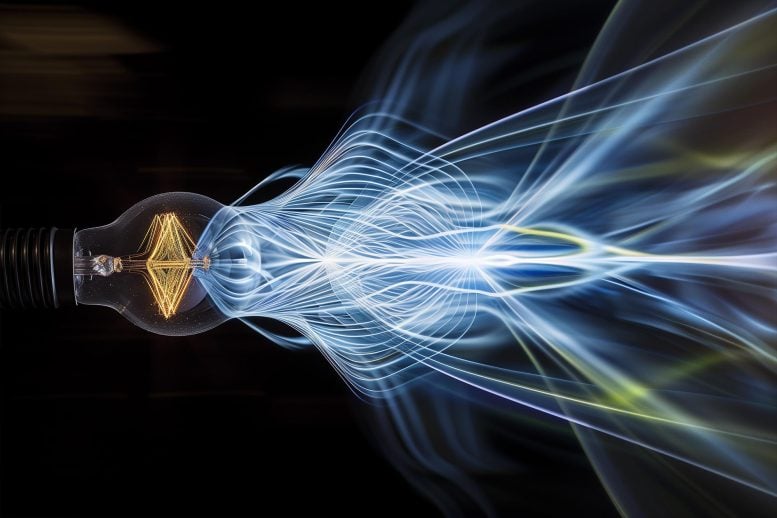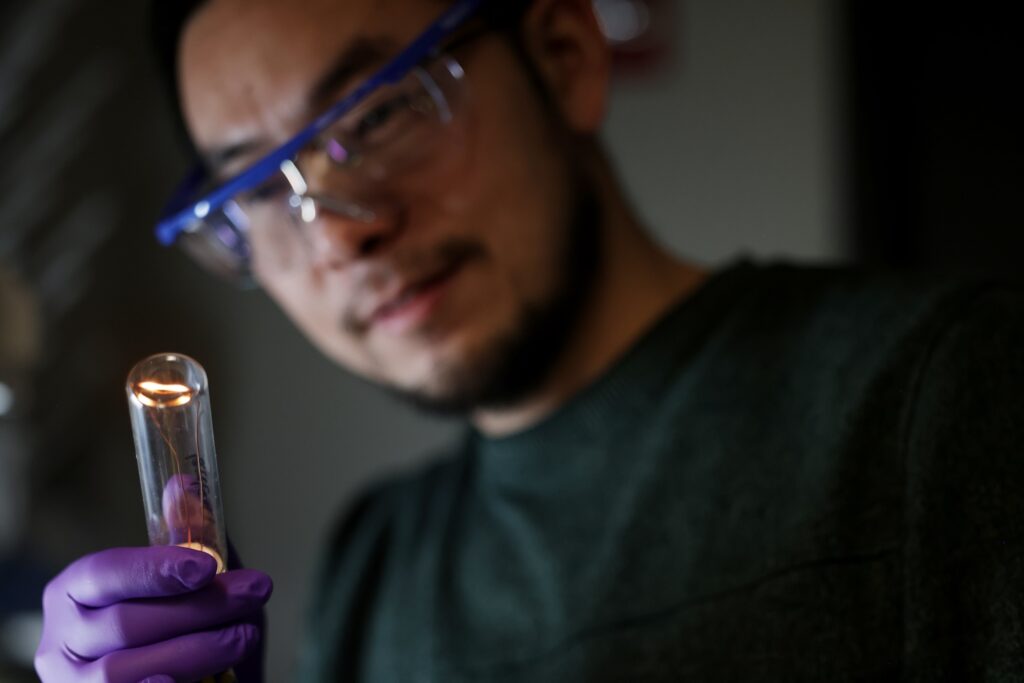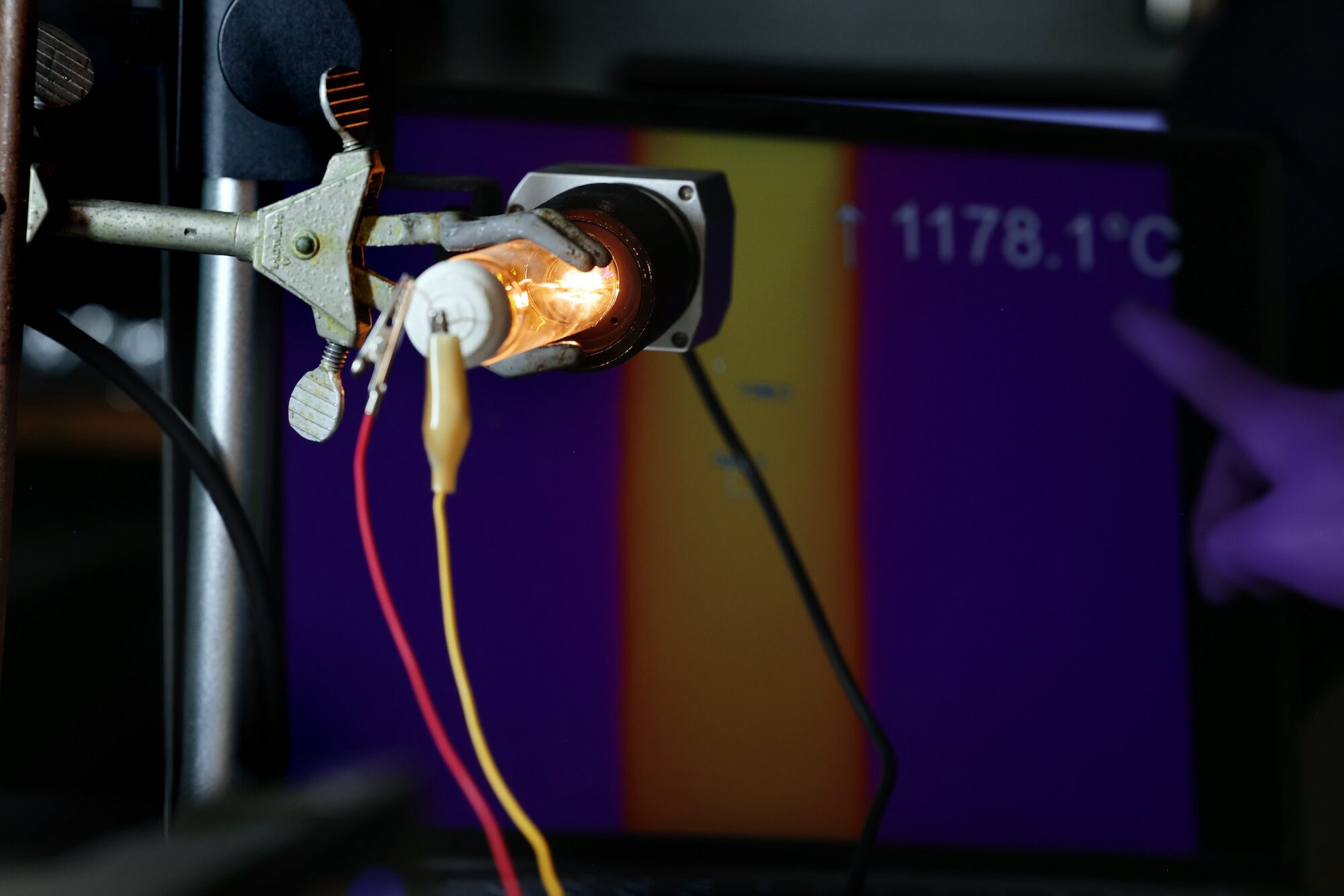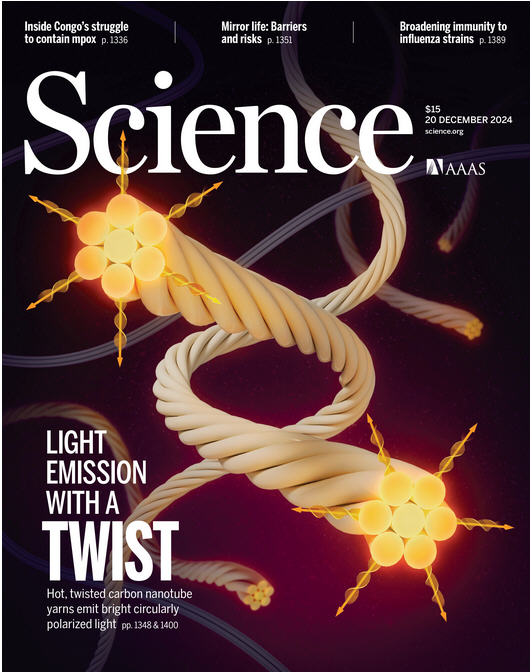博文
扭曲的爱迪生:螺旋光如何改变自主视觉
 精选
精选
||
扭曲的爱迪生:螺旋光如何改变自主视觉
诸平
据美国密歇根大学(University of Michigan, Ann Arbor, MI, USA)2024年12月26日提供的消息,扭曲的爱迪生:螺旋光如何改变自主视觉(Twisted Edison: How Spiraling Light Could Transform Autonomous Vision)。
密歇根大学的研究人员发现了一种利用类似于爱迪生灯泡的技术产生明亮扭曲光的方法。这一突破重新审视了黑体辐射的原理,为先进的机器人视觉系统提供了潜力,该系统能够区分光特性的细微变化,例如生物体或物体发出的光。
明亮、扭曲的光:一项惊人的创新(Bright, Twisted Light: A Surprising Innovation)
Science, Volume 386, Issue 6728, 20 Dec 2024
Fig. 5 COVERAll objects emit a black-body spectrum, but Planck’s law does not say whether this emission is polarized. Heated twisted fibers are shown to emit circularly polarized black-body radiation when their helical pitch is comparable to the wavelength of light. These fibers could be used as circularly polarized light sources at extreme temperature conditions and for object identification tags based on specific polarization signatures. See pages 1348 and 1400. Illustration: A. Mastin/Science.
密歇根大学的研究人员已经证明,利用类似爱迪生标志性灯泡(Edison’s iconic light bulb)的技术,可以产生明亮、扭曲的光。这一发现不仅加深了我们对基础物理学的理解,而且为机器人视觉系统和其他涉及光在空间中以螺旋模式旋转的应用开辟了新的可能性。相关研究结果于2024年12月20日已经在《科学》(Science)杂志发表,且成为《科学》(Science)杂志2024年第386卷,第6728期的封面介绍论文(见图5所示)。原文详见:Jun Lu, Hong Ju Jung, Ji-Young Kim, Nicholas A. Kotov. Bright, circularly polarized black-body radiation from twisted nanocarbon filaments. Science, 2024, 386(6728):1400-1404. DOI: 10.1126/science.adq4068. Epub 19 December 2024. https://doi.org/10.1126/science.adq4068
参与此项研究的除了来自美国密歇根大学的研究人员之外,还有来自美国特洛伊的伦斯勒理工学院(Rensselaer Polytechnic Institute, Troy, NY, USA)的研究人员。
密歇根大学化学工程助理研究员、该研究论文的第一作者陆军(Jun Lu音译)解释说:“用电子或光子发光等传统方式产生扭曲的光很难产生足够的亮度。”
为新物理学重温旧思想(Revisiting an Old Idea for New Physics)
“我们逐渐注意到我们实际上有一种非常古老的方法来产生这些光子不是依靠光子和电子激发,而是像爱迪生发明的灯泡。”
每一个有热量的物体,包括你自己,都在一个与其温度相关的光谱中不断地发射光子。当物体的温度与其周围环境温度相同时,它也吸收等量的光子,这被理想地称为“黑体辐射”(“blackbody radiation”),因为黑色吸收所有的光子频率。
虽然钨丝灯泡的灯丝比它周围的环境要热得多,但黑体辐射的定义定律——普朗克定律(Planck’s law)提供了一个很好的近似它发出的光子光谱。所有可见光子加在一起看起来就像白光,但是当你把这些光穿过棱镜时,你可以看到其中不同光子组成的彩虹。
这种辐射也是你在热图像中显得明亮的原因,但即使是室温的物体也在不断地发射和接收黑体光子,使它们也隐约可见。
形状和偏振:一个新的视角(Shape and Polarization: A New Perspective)
通常,发射辐射的物体的形状在大多数情况下没有得到太多的考虑(就像在物理学中经常考虑的那样),物体可以想象成一个球体。但是,虽然形状不会影响不同光子的波长光谱,但它可以影响不同的特性:它们的偏振(polarization)。
通常,来自黑体源的光子是随机偏振的,它们的波可以沿任何轴振荡。新的研究表明,如果发射器在微米或纳米尺度上被扭曲,每次扭曲的长度与发射光的波长相似,黑体辐射也会被扭曲。光中扭曲的强度,或其椭圆偏振主要取决于两个因素:光子的波长与每次扭曲的长度有多接近,以及纳米碳或金属材料的电子特性。
手性光与机器人视觉(Chiral Light and Robotic Vision)
扭曲的光也被称为手性光,因为顺时针和逆时针的旋转是彼此的镜像。这项研究是为了证明密歇根大学团队想要进行的一个更实用的项目的前提:使用手性黑体辐射来识别物体。他们设想机器人和自动驾驶汽车可以像螳虾(mantis shrimp)一样看东西,区分不同旋转方向和扭曲程度的光波。
扭曲光的实际应用(Real-World Applications for Twisted Light)
上述研究论文的通讯作者、密歇根大学欧文·朗缪尔化学科学与工程杰出教授(Irving Langmuir Distinguished Professor of Chemical Sciences and Engineering)、美国国家科学基金会复杂粒子和粒子系统中心{NSF Center of Complex Particles and Particle Systems (COMPASS)}主任尼古拉斯·科托夫(Nicholas A. Kotov)说:“手性纳米结构在黑体辐射物理学方面的进展是本研究的核心。这样的发射体在我们周围无处不在,例如,这些发现可能对自动驾驶汽车区分鹿和人很重要,因为鹿和人发出的光波长相似,但螺旋度不同,因为鹿的皮毛和人们穿戴的织物有不同的卷曲度。”

亮度与未来挑战(Brightness and Future Challenges)
虽然亮度是这种方法的主要优点,因为它产生的扭曲光比其他方法亮100倍,但光包括波长和扭曲的广谱。该团队对如何解决这个问题有一些想法,包括探索建立一种依赖于扭曲发光结构的激光器的可能性。
尼古拉斯·科托夫还想进一步探索红外光谱。在室温下黑体辐射的峰值波长大约是10,000 nm或0.01 mm。“这是一个有很多噪音的光谱区域,但有可能通过椭圆偏振来增强对比度,”尼古拉斯·科托夫说。
这项研究得到了美国国家科学基金会通过密歇根大学复杂粒子系统研究中心(COMPASS)和海军研究办公室(Office of Naval Research)的支持。
上述介绍,仅供参考。欲了解更多信息,敬请注意浏览原文或者相关报道。
Upon heating, carbon nanotube yarns or tungsten wires mechanically twisted to have submicrometer-scale chirality can generate circularly polarized light ranging from the visible to midinfrared wavelengths. Lu et al. found that unlike other chiral emitters, these blackbody emitters have no vibronic state limitations and can achieve high brightness (see the Perspective by Bharadwaj and Jacob). The spectral characteristics were modeled with a mechanism that reconciled Planck’s law and the fluctuation-dissipation theorem. Ceramic composites allowed the electrically heated emitters to achieve long lifetimes. —Phil Szuromi
Planck’s law ignores but does not prohibit black-body radiation (BBR) from being circularly polarized. BBR from nanostructured filaments with twisted geometry from nanocarbon or metal has strong ellipticity from 500 to 3000 nanometers. The submicrometer-scale chirality of these filaments satisfies the dimensionality requirements imposed by fluctuation-dissipation theorem and requires symmetry breaking in absorptivity and emissivity according to Kirchhoff’s law. The resulting BBR shows emission anisotropy and brightness exceeding those of conventional chiral photon emitters by factors of 10 to 100. The helical structure of these filaments enables precise spectral tuning of the chiral emission, which can be modeled using electromagnetic principles and chirality metrics. Encapsulating nanocarbon filaments in refractive ceramics produces highly efficient, adjustable, and durable chiral emitters capable of functioning at extreme temperatures previously considered unattainable.
https://wap.sciencenet.cn/blog-212210-1466291.html
上一篇:“沙漠玫瑰”如何永远改变药物输送
下一篇:科学家用光让分子完成了不可能的事情




